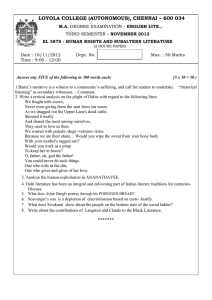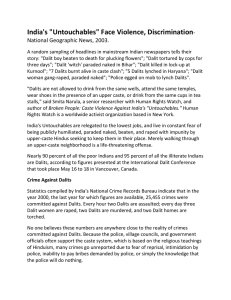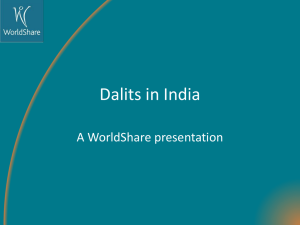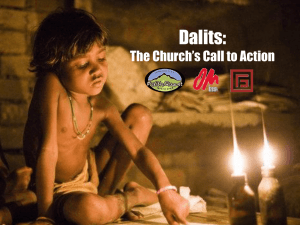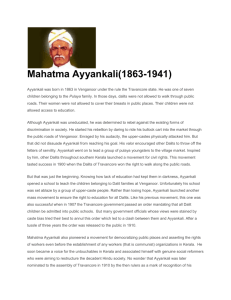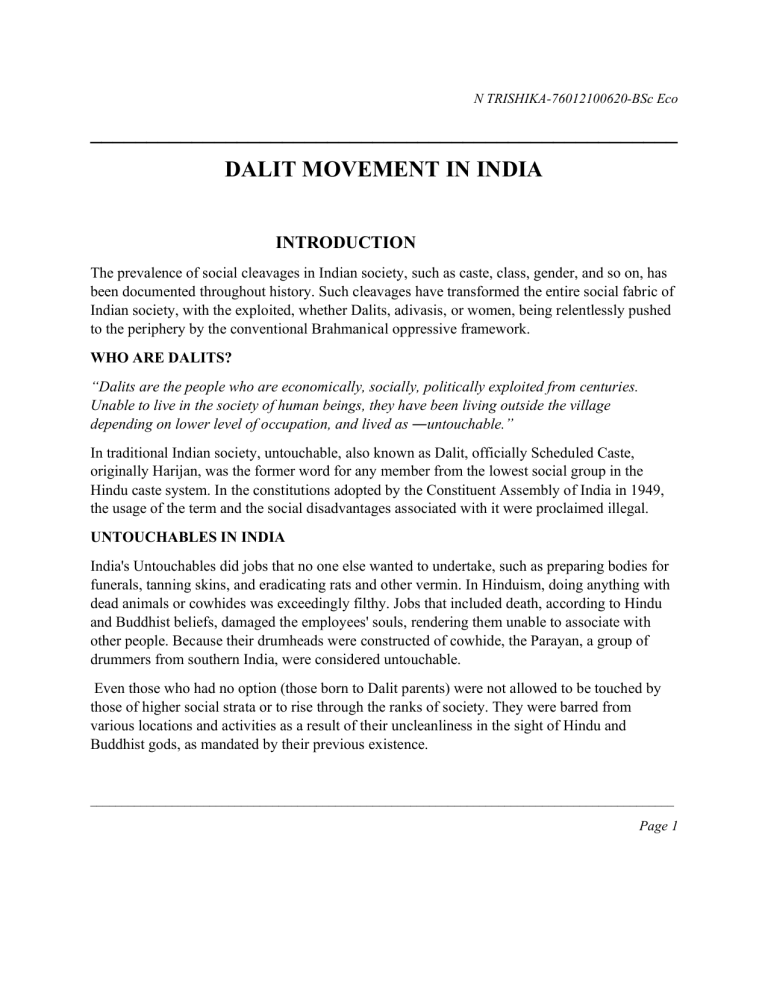
N TRISHIKA-76012100620-BSc Eco ____________________________________________________ DALIT MOVEMENT IN INDIA INTRODUCTION The prevalence of social cleavages in Indian society, such as caste, class, gender, and so on, has been documented throughout history. Such cleavages have transformed the entire social fabric of Indian society, with the exploited, whether Dalits, adivasis, or women, being relentlessly pushed to the periphery by the conventional Brahmanical oppressive framework. WHO ARE DALITS? “Dalits are the people who are economically, socially, politically exploited from centuries. Unable to live in the society of human beings, they have been living outside the village depending on lower level of occupation, and lived as ―untouchable.” In traditional Indian society, untouchable, also known as Dalit, officially Scheduled Caste, originally Harijan, was the former word for any member from the lowest social group in the Hindu caste system. In the constitutions adopted by the Constituent Assembly of India in 1949, the usage of the term and the social disadvantages associated with it were proclaimed illegal. UNTOUCHABLES IN INDIA India's Untouchables did jobs that no one else wanted to undertake, such as preparing bodies for funerals, tanning skins, and eradicating rats and other vermin. In Hinduism, doing anything with dead animals or cowhides was exceedingly filthy. Jobs that included death, according to Hindu and Buddhist beliefs, damaged the employees' souls, rendering them unable to associate with other people. Because their drumheads were constructed of cowhide, the Parayan, a group of drummers from southern India, were considered untouchable. Even those who had no option (those born to Dalit parents) were not allowed to be touched by those of higher social strata or to rise through the ranks of society. They were barred from various locations and activities as a result of their uncleanliness in the sight of Hindu and Buddhist gods, as mandated by their previous existence. _____________________________________________________________________________________________ Page 1 DALIT MOVEMENT IN INDIA _____________________________________________________________________________ Untouchables were not allowed to visit Hindu temples or get education. They were forbidden from collecting water from village wells since their presence tainted the water for the rest of the community. They were forced to dwell outside of village limits and were unable to enter the homes of higher caste members. An Untouchable was required to throw himself face down on the ground whenever a Brahmin or Kshatriya approached, preventing even their dirty shadows from touching the higher caste. CAUSE OF THEIR UNTOUCHABILITY If we go back in time, the main reason is the establishment of the 'Caste System,' which led to the marginalization of dalits. It was with the Aryans who arrived from the Middle East and settled in the lush area of the Ganges after a battle with the civilization's original inhabitants. The Aryans vanquished the people, who were well-versed in the tactics as evidenced by historical accounts. Minority Aryans, overcame the majority Dalits by using their Divide and Rule methods, as Braj Ranjan Mani thought, because they wouldn't be able to overcome the majority if they didn't. Even now, the Brahmins use this strategy. The development of the Rig Veda later in the Vedic period, with the Purusha shukta in its tenth book, provided the framework for the subjugation of the people in their own land. Shudra Varna's inhabitants were converted into untouchables later in the 5th century. As a result, the Brahmin hegemony began, followed by Dalit exploitation. Brahamins considered themselves equivalent to the God, it was the Arya-Brahamins who developed the institution Varna and put themselves at the top. Many people like Manu , Kautilya etc who themselves were Brahamins propagated the existence of the caste system. The same was said by Gandhi ,'Change is to create disorder. This implies that the Brahmins should remain at the top of the pyramid, while the Dalits should remain at the bottom. The Dalits should not be raised, even if they die as a result of the condition. This is Brahmanism, which has its roots in the ancient Vedas and has lead to inequality. The Dalits were made to accept their exploitation and claim that this is the result of their own deeds in the past birth. They were told that they might have done some bad deed in the previous life and hence are facing such exploitation in this birth. They should not protest, as this is the will of the God, that is the Brahamins. When the historic works are examined, the goal of the authors becomes clear: to create and perpetuate Brahmanical hegemony while exploiting non-Brahmins, primarily Dalits. ______________________________________________________________________________ Page 2 DALIT MOVEMENT IN INDIA _____________________________________________________________________________ DALIT MOVEMENT IN INDIA “The organizational or institutional efforts made by Dalit leaders for the liberation of the downtrodden masses could be termed as Dalit movement. It is a movement of protest against untouchability, casteism and superstitions. It aims at the uplift of the Dalits to the level of non Dalits.” It is the outcome of Dalits' recognition of their own identity as human beings, with the same physical and mental capacity as other people and the same right to enjoy all human rights "without any infringement, abridgement, or limits." The motto of Dalit movement was 'Education, Association and Agitation'. CAUSES OF THE MOVEMENT The Dalit Movement is the consequence of centuries of animosity in the Dalits' hearts as a result of the upper castes' cruel deeds in India. Dalits were barred from mainstream society and were only permitted to engage in menial jobs such as cleaning dry latrines, sweeping, tanning, or as landless labor for pitiful daily earnings. This practiced has forced the Dalits to live in inhumane conditions. They did not have the geographical isolation that tribes did since they lived in Hindu communities. They were exiled to the forests, while the Brahmins occupied the mainland. They were expected to serve individuals from all walks of life and to perform all of the filthy work. They were forbidden from visiting those mainland places in every way; they were not allowed to wear respectable clothing or decorations, and they were untouchable.The Dalits have never been given their true place in society. They are now considered a marginalized group in society. They were denied access to resources, both material and intellectual, and they were exploited as a result. As a result of being denied equal status, the Dalits resolved to cease following such uneven practices in society where one group profits by taking from the other and launched their campaign. ROLE OF DR. BHIM RAO AMBEDKAR Dr. Bhimrao Ambedkar is known for his foresight in crafting India's Constitution. He used a variety of strategies to protect Dalit rights. Ambedkar began a movement against Dalit prejudice by influencing public opinion through his works in many publications, including Mook Nayak, Vahishkrit Bharat, and Equality Janta, which he founded to promote Dalit rights. ______________________________________________________________________________ Page 3 DALIT MOVEMENT IN INDIA _____________________________________________________________________________ He attempted to mobilize Dalits politically in order to combat the socio-economic challenges that they were experiencing in society. In 1936, Dr. Ambedkar founded the Independent Labour Party. Dr. Ambedkar commanded the formation of the first Mahar Regiment in 1941. He pushed for proper representation for Dalits in legislatures, which resulted in the Government of India Act, 1919, which allocated one seat in the central Legislative Assembly to the poor. The Poona Pact of September 1932 stipulated that seats from the general electorate be reserved for the poor. In 1956, he, his wife, and around 5,00,000 followers were converted to Buddhism in an official public ceremony in Nagpur. DALIT’S PANTHER MOVEMENT Dalit Panthers is a social group started in April 1972 in Mumbai by Namdev Dhasal.The issue surrounding Dhale's piece "Kala Swatantrata Din" (Black Independence Day), which was published in "Sadhana" in 1972, generated a huge stir and brought the Dalit Panthers to the attention of Maharashtra. The movement was a dramatic break from previous Dalit movements because its initial push for militancy, which included the use of rustic weaponry and threats, gave it a revolutionary hue. They made a connection between their sufferings and the struggles of all oppressed people across the world.This document's apparent socialist stance ran opposite to Ambedkar's acknowledged legacy as envisioned. ROLE OF KANSHI RAM Kanshi Ram was popularly known as Bahujan Nayak[1] or Manyavar[2] or Saheb[3], was an Indian politician and social activist who worked for the betterment and political mobilisation of the Bahujans, India's backward or lower caste people, which include untouchable groups at the lowest of the caste system. Kanshi Ram left the DRDO in 1971 and founded the SCs, STs, OBCs, and Minorities Employees Welfare Association with his coworkers. Attempts were made through this association to look into the concerns and harassment of the above-mentioned employees and come up with a viable solution. Another major goal was to educate people about the caste system and raise awareness about it. ______________________________________________________________________________ Page 4 DALIT MOVEMENT IN INDIA _____________________________________________________________________________ Kanshi Ram and his colleagues founded the BAMCEF (Backward And Minority Communities Employees Federation) again in 1973. He founded the Bahujan Samaj Organization, a fullfledged political party, in 1984. Unlike 'dalit,' which essentially represented just the scheduled castes, the 'Bahujan' identity comprised all SCs, STs, BCs, OBCs, and religious minorities. DALIT LITERARY MOVEMENT During the Mukti movement, Dalit literature, or literature generated by Dalit awareness, first appeared. Following the foundation of the Dalit Panthers, a slew of Dalit poetry and stories expressing the Dalits' plight arose, the origins of which can be found in the Vedas and Smritis' regulations and laws. All of this literature stated that the Dalit Movement fights not only against the Brahmins, but also against anybody who engages in exploitation, whether they are Brahmins or Dalits. Dalit writers created new revolutionary songs, poetry, novels, and memoirs. All of their emotions were exploding in the form of essays. Writing is more than just writing; it is an act that reflects one's ongoing battle with evil. The writings were so powerful that each one of their words might draw blood. Every hamlet sang the songs, and the entire community read the poems and other literature. Educated Dalits and intellectuals began to discuss the concerns of the poor, as well as exploitation and humiliation by the higher castes. Without hesitation, educated Dalits attempted to convey the essential changes in society to their uneducated brothers. Dalit literature attempts to relate the predicament of Dalits in the past to that of the present and future generations, not to incite hatred, but to raise awareness of their plight. It is not caste literature, but it is linked to the Dalit struggle for social and economic reform through a democratic social movement. POWER MEANS TO ATTAIN DIGNITY The Dalits' plight was such that they were forced to live like animals. And it was a dearth of education that contributed to the Dalits' transformation into beasts. The only thing that was necessary to terminate that situation of exploitation and live a life of dignity was power. Only power has the ability to cut power on the other side. As a result, knowledge is the primary requirement for achieving power. As a result, Phule and Ambedkar placed a strong focus on Dalit education, which will provide them with not just reason and judgement capacity, but also political power, and hence socioeconomic standing and a dignified existence. ______________________________________________________________________________ Page 5 DALIT MOVEMENT IN INDIA _____________________________________________________________________________ They understood that attaining power is either an end in itself or a means to other purposes in politics. To put it another way, if the Dalits gain power, they won't have to ask the upper castes. They will also benefit from increased economic and educational prospects. Till then the brahimins and te upper caste enjoyed the social power. As a result, the Dalits require power in order to exert influence over the country's economic situation and, as a result, its politics. As a result, they emphasized the need of education as a necessary condition for regaining their place in Indian society. Without knowledge, intelligence was lost; without intellect, morality was lost; without morals, dynamism was lost; without dynamism, money was lost; without money, Shudras were degraded; and all of this pain and calamity was caused by a lack of information. However, it was Phule who understood the need of education for the first time. Gandhi went on a hunger strike up to death to protest against the reservation of Dalits for the legislation and hence Dr. Ambedkar had to give in. As a result, education would help them understand the reality about Brahmanism in Indian society and motivate them to fight against caste-based barbaric behaviors. Only by starting agitation in the true sense will the Dalits be able to achieve power and win the anti-exploitation struggle, and only then will they be able to enjoy a life of equal status and dignity. CONCLUSION Even though India gained independence, the Dalits continue to be humiliated. Untouchability has been eradicated, but not the practice of unfairness. Discrimination can only be overcome via education. As a result, the social reform movement will only succeed if all Dalits band together to fight for equality. They should, however, realize that caste, which is profoundly ingrained in people's minds, cannot be eradicated. So, in this case, social transformation would imply the elimination of discriminatory practices and the acquisition of rights, both of which are important for the upliftment of society's most marginalized people, the Dalits. They should, however, realize that caste, which is profoundly ingrained in people's minds, cannot be eradicated. So, in this case, social transformation would imply the elimination of discriminatory practices and the acquisition of rights, both of which are important for the upliftment of society's most marginalized people, the Dalits. ______________________________________________________________________________ Page 6
